By Jeffrey A. Rendall, Photos by Jeffrey A. Rendall
DANIELS, WV – “There’s a story with every golf course as you know, but this one has more than any,” remarked golf course architect Tom Clark, in referring to his recently opened Woodhaven golf layout at the Resort at Glade Springs in West Virginia.
Clark knows golf courses having been in the design business for forty years – and when he says that Woodhaven’s story tops them all, it must be quite a tale. Simply put, the Woodhaven Course is on such spectacular land in the hills of West Virginia that you’ll be left awe-inspired by the mere fact that they were able to build golf holes there – and that’s before you even know what it took to build it. |
|
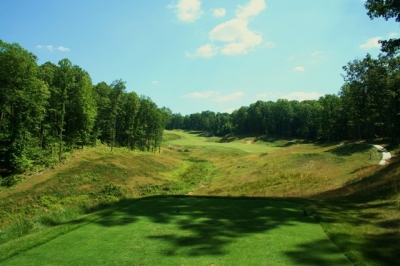 |
| As beautiful as it is daunting, the view from the par five 18th hole. |
Woodhaven’s construction will offer plenty of lessons for those coming after, a case study on project management that will be looked to for a long time. The end result brings a new golf layout that joins Glade Springs’ previous offerings (Stonehaven and Cobb), producing a golf destination that ranks in the top tier with the best in the Mid-Atlantic region.
Clark says he would put Glade’s golf product against any resort in the region – and he’s got a very strong argument that it’d come out ahead.
That’s easy to say now that all of the courses are open and accepting business, but several years ago there was considerable doubt that Woodhaven would even exist at all.
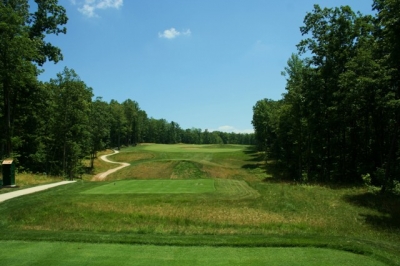 |
| If you clear the fairway bunker off the tee of the par four 3rd hole, there's an extremely generous landing area awaiting you. |
Clark starts the story: “We built Stonehaven (which is at the resort center) with the idea that there’d be another golf course coming after it at Glade Springs, but it wouldn’t be located adjacent to the other courses, and it would be part of a residential development.”
He continues, “We’d already routed the course (Woodhaven), and then the developer (Cooper Land Development) came to us and said there would be some changes.”
Anyone who’s familiar with golf design knows that changes come with the territory, but Clark wasn’t prepared for what happened next. Nearly every golf course construction project in these times involves proper management and mitigation of wetlands (now called ‘Waters of the U.S.A.’), but Clark had been informed prior to routing that there weren’t going to be any ‘Waters of the U.S.A’ issues on the Woodhaven layout.
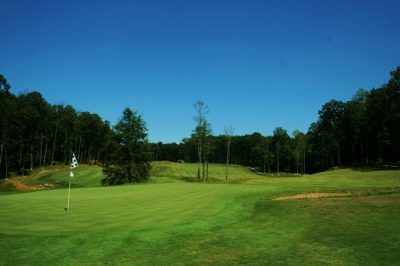 |
| From in back of the 10th hole, you'll see that trees and a split fairway present different mental tests to try and make a birdie. |
“We thought they’d received jurisdiction from the Corps of Engineers prior to laying out the golf holes, but then we discovered that wasn’t the case. We were well into the clearing process for the course (about a year after routing the corridors) and then the court came in and said ‘this is all waters of the U.S.’ and we literally had to stop and basically start over,” Clark said.
Upon looking at the map, Clark saw what was already a fairly tight site (due to topography and real estate) being squeezed even further by acreage that they could no longer use. Waters of the U.S.A. can be filled and piped, but there’s a heavy mitigation cost involved – which would have made the project quite a bit more expensive.
Coming at the start of the housing downturn, it was an expense that the developers couldn’t cover. The only alternative was to take the available land (and the restrictions) and work with it.
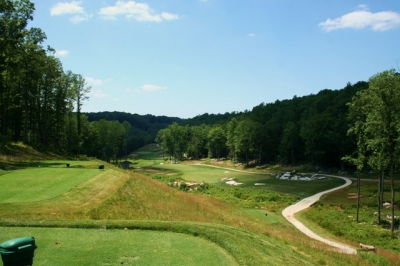 |
| Perhaps the most spectacular view at Woodhaven, the tee of the par three 5th hole presents good looks of three different golf holes. |
The bad news unfortunately didn’t end with the wetlands problems. The budget was cut even further by money that was needed in other parts of the community, so the construction group had to tighten their belts even further.
“Because the budget was cut by $1.5 million after we’d already started building the course, quite a few allowances had to be made to be able to come up with a finished product,” Clark explained. “We were down to a single row irrigation system, no sod (the course was completely seeded, which is rare these days), five-foot cart paths, three-quarters of the drainage pipe was taken out, the greens were downsized by at least 1500 square feet, and the same with the tees.”
If only Congress would do a similar hatchet-job on the federal budget, we’d all be a lot better off with the national debt situation.
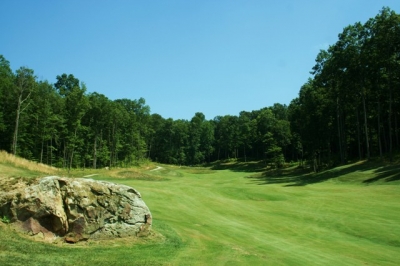 |
| Large rock outcroppings are prevalent throughout the journey at Woodhaven. Here, the fairway of the par four 16th hole. |
Water was another concern. “We were going to build lakes all throughout Woodhaven that would have held plenty of water for irrigation purposes, but those were eliminated because of the ‘Waters of the U.S.A.’ concerns and the budget. We also couldn’t get a water withdrawal permit from Glade Creek, so we finally ended up building a pipeline to the main resort – and that came out of the budget as well,” Clark lectured.
Despite the delicate financial tightrope, Woodhaven is about as playable as a course can be on this type of ground. There are some blind shots, and the playing areas are fairly narrow in some spots, but the key is to play to the wide side and you’ll usually come out okay.
That’s not to say it isn’t challenging – or daunting. The first time we played the course, we agreed it was one of the toughest we’d ever tried. From the back sets of tees, there are carries on nearly every tee shot, and on several holes there are carries into the greens as well.
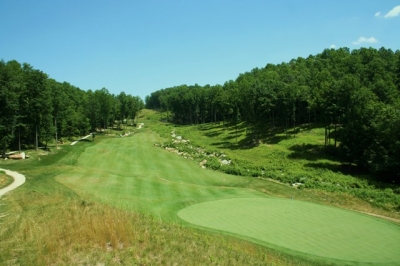 |
| Looking down from in back of the short par four 6th hole (286-yards), you'll see there's a good sized target for those who might want to try and reach it from the tee. |
In all fairness, two holes at Woodhaven are going to make it famous – or infamous – for their difficulty. The first ‘toughie’ is the par four eighth hole, which requires a carry over a ravine off the tee (from the blue and black tees) to a very wide playing area. No problem there – but the hole doglegs left sharply and you’ll definitely want to cut as much as you can off the tee (bringing more of the ravine into play), because the second shot’s about as daunting as you’re going to find anywhere.
From the fairway you’re looking up at the flag, separated by another ravine – and the green is about 30 feet above you. There is a bailout area to the left (which would cut off a lot of the distance), but for many recreational players, it’s an extremely difficult shot, both uphill and long. Clark added that the second shot’s carry was originally supposed to be filled and piped – which would still have made it a tough hole, but not to the degree that it is today.
The other tester is the par four 11th hole, which requires a long-iron or fairway wood off the tee to another good sized landing area. The second shot will be the tough one again – downhill and at long-iron/fairway wood distance to a green complex that looks small from where you’re playing. Another long carry to navigate.
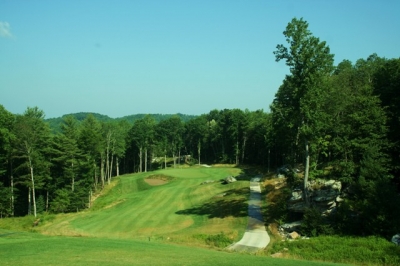 |
| Looking down from the fairway of the par four 11th hole, it's a mid to long iron shot to reach the well guarded green complex. |
That’s not to say these two holes can’t be had – and that they’re blatantly unfair. You’ll know what you need to do, and have to execute some challenging shots, just as you would on any golf course. It’s just that the price for failure means lost balls and penalty strokes, and the margin of error is pretty thin.
There are plenty of other opportunities for those golf maladies at Woodhaven as well, but it doesn’t detract from the enjoyment of the experience. Rob Seiter, Woodhaven’s Superintendent, says you should take the quality of the experience into account when you play the course, and that it’s an environment that you rarely find at golf facilities.
“If you’ve ever played at the Raven at Snowshoe (often mentioned as West Virginia’s most scenic course), that’s what a lot of people are comparing Woodhaven to. It’s just so visually stimulating, and it looks so intimidating – yet once you get around it two or three times, you realize that it’s extremely playable,” Seiter said.
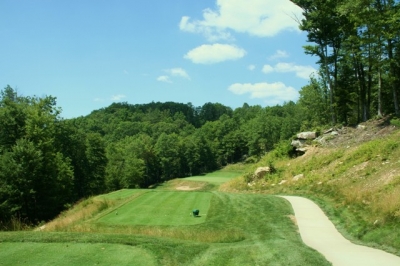 |
| Choose your club carefully on the 200-yard, par three 7th hole. |
Playability was the constant concern during construction, Seiter remembered. With a lot of the cost-cutting decisions in mind, they (which certainly includes the construction contractors, Donnie and Ronnie Adkins from the Aspen Corporation) first and foremost looked at every situation and asked: we know it’s difficult, but is it playable?
The answer invariably was yes (with the possible exceptions of the two holes mentioned previously, which couldn’t be changed because of the budget), and the crew’s careful decision-making process is visible throughout the course.
It’s even built-in to the layout, as demonstrated by the par five 10th hole (541-yards), which offers a risk-reward split fairway, bisected by a creek. The hole is very wide, but you’ll still have to make thoughtful decisions about where to place your ball off the tee and the angle you’ll want to leave going into the green (which is guarded by a few trees).
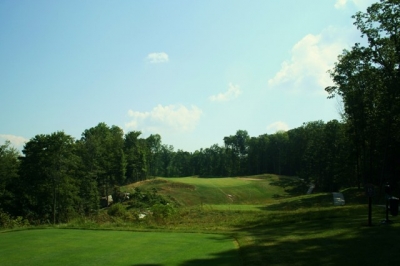 |
| Not evident from this view is the par four 15th hole's rather unique shaped green -- but it's all beautiful. |
Every course requires a period of adjustment to play well, but that too might have found its ultimate truth at Woodhaven. Clark says he’s played from every set of tees and highly recommends playing from the white tees (6300 yards) for all but the best players – which will at least allow you to see your targets and have manageable approach distances.
Because of the more limited irrigation on the course (again, due to the budget), during dry times the fairways will play hard and fast, which will mitigate some of the distance on the uphill holes and make the downhill holes considerably shorter. But don’t be fooled – this isn’t a course where you can grip it n’ rip it.
As a new course, Woodhaven will ‘soften’ some with time, much like its sister layout, Stonehaven, has become much less intimidating since the first time we saw it. Clark says the grow-in at Stonehaven has brought the rough to the perfect height and thickness, great for keeping balls from bounding into the trees but not so harsh that it can’t be played out of.
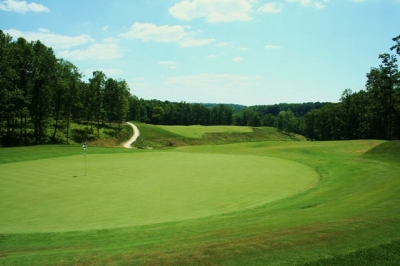 |
| The 473-yard, par four 8th hole richly deserves its #1 handicap designation. |
Woodhaven will follow a similar pattern, and with the passing of a couple seasons, a lot of the playability issues will take care of themselves.
We’ve highlighted some of the ‘trouble’ holes at Woodhaven, but there were also a number of highlight holes, including the par three fifth hole. Looking from the tee box you can see back up the slope to the par five fourth hole as well as past the green to the short par four sixth hole in a little valley. It’s a view that’s quintessential Woodhaven.
Likewise, the par three twelfth hole will leave an impression, because there’s a sheer drop from the tee boxes down to the green. Take the elevation change into consideration when choosing a club, but even from the back tees (169-yards) it probably plays little more than a pitching wedge.
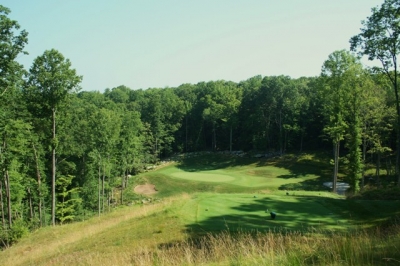 |
| The shortest hole on the course (169-yards), the par three 12th hole nonetheless represents a challenge to choose the right club. |
The par five eighteenth hole is as beautiful as it is challenging. Playing 557-yards from the back tee, you’ll need a lot of air under your ball just to fly the trouble to reach the landing area. Once there, you’re greeted with a slope of fescue staring you in the face, which ideally you should try to fly to reach the upper left-side second shot landing area. If you do that, you’ll be able to see the flag on your approach.
It’s hard to sum up what a round at Woodhaven represents, because it runs the gamut of emotions from unrestrained exhilaration to sheer frustration. Perhaps Clark says it best: “It was a very difficult site. I mean, at the Cobb course he (George Cobb) took the best land, and I can’t blame him. And then at Stonehaven we had better land to work with, but it was very mountainous. For this one, we were pushed to the limits because they said, ‘unless you can hang these holes over the cliff, and use all the undevelopable area, we can’t justify building this course.’”
“So, that’s what I did. And I think the quality of the end result will stand the test of time,” Clark concluded.
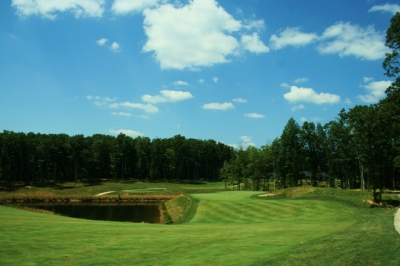 |
| The approach to the par five 9th hole is one of only a couple shots at Woodhaven where a pond comes into play. |
Case closed.
Glade Springs Resort – Golf, and Much, Much More
Family-friendly Glade Springs Resort is an outdoor oriented destination, with a multitude of activities to choose from before, after, or even instead of golf (okay, maybe not instead of). The resort offers a full-service equestrian center, a pool, Spa, tennis courts, hiking trails and horseback riding trails, as well as several restaurants for your culinary needs.
For the outdoorsman in you, there’s fly-fishing, casting classes, whitewater rafting, and target shooting. Snow skiing is nearby for the winter months. The golf courses remain open year-round, snow cover permitting.
Sleeping accommodations range from hotel accommodations at the Inn (new since we last visited, and very well accented) to one bedroom suites, to six bedroom lodges – bring your group of up to forty, and you’ll find space for them. Consult the website at http://www.gladesprings.com for more details, as well as contact and booking information.
For our visit, we chose the Oak Lane Villas which are located adjacent to the Cobb Course, which featured a very roomy three-bedroom (three bath) cottage, full kitchen facilities, and a wonderful screened porch sitting area, perfect for relaxing after an afternoon on the links. As always on our journeys, we appreciated the kitchen facilities which allowed for meal flexibility as well as saving a little money on vacation.
Included in your visit is access to Glade Springs’ Leisure Center, which offers a pool, Jacuzzi, workout facilities and bowling, amongst other activities. It’s a tremendous amenity for families, and makes Glade Springs even more of a multi-faceted resort destination.
Glade Springs Resort is now affiliated with the Greenbrier – making it a powerful one-two resort punch. Consult the Website for package rates.
Details:
Daniels, WV 24986
Phone: (800) 634-5233; (304) 763-2000
FAX: (304) 763-3398
Website: www.gladesprings.com
Glade Springs Village: http://www.gladespringsvillage.com
Course Designer: Tom Clark of Ault, Clark & Associates
Glade Springs’ Owner: Jim Justice (who also acquired the Greenbrier)
Woodhaven: Tees/Yardage/Slope/Rating
Consult the Website for stay & play package deals.
As probably would be expected for this type of course, no walking allowed.
| Related Links | Comments on this article? | |
|
Maryland National Golf Club Hollow Creek Golf Club Rocky Gap Resort PB Dye Golf Club in Ijamsville Whiskey Creek Golf Club |
E-mail Jeff Rendall, Editor: jrendall@golftheunitedstates.com |













